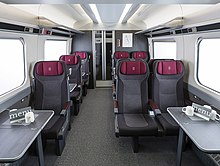British Rail Class 800
| British Rail Class 800 Super Express | |
|---|---|
 Hitachi Class 800 undergoing dynamic testing at Old Dalby | |
 Class 800 interior as seen at the opening of the Hitachi Rail Vehicle Manufacturing Facility. | |
| In service |
|
| Manufacturer | Hitachi |
| Built at |
|
| Family name | A-Train |
| Replaced | |
| Number under construction |
|
| Formation | 5-car: DPTS-MS-MS-MC-DPTF[1] |
| Operators | |
| Lines served |
|
| Specifications | |
| Car body construction | Aluminium |
| Car length | 26 metres (85 ft 4 in) |
| Width | 2.7 metres (8 ft 10 in) |
| Maximum speed |
|
| Weight | 300 tonnes (5-car), 540 tonnes (9-car)[3] |
| Axle load | 15 tonnes[3] (13 tonnes without diesel engine) |
| Traction system | 120 kW (160 hp) per axle[1] |
| Prime mover(s) | MTU 12V 1600 R80L |
| Engine type | V12 diesel |
| Cylinder count | 12 |
| Power output | 560 kW (750 hp) per engine[1] |
| Acceleration | 0.70m/s/s[1] |
| Deceleration | 1.00m/s/s service, 1.20m/s/s emergency[1] |
| Electric system(s) | 25 kV 50 Hz AC overhead lines |
| Current collector(s) | Pantograph |
| Safety system(s) | AWS, TPWS, ETCS, ATP |
| Track gauge | 1,435 mm (4 ft 8+1⁄2 in) standard gauge |
| Notes/references | |
| 1:^ The engines are fully rated at 700 kW (940 hp), but have been de-rated on these units.[4] | |
The Class 800 Super Express is a type of electro-diesel train to be used in the United Kingdom, based on the Hitachi A-train design. They are to be built by Hitachi from 2015. The first units will be delivered for the Great Western Main Line (GWML), beginning service there in July 2017 and on the East Coast Main Line (ECML) from 2018. These trains will be built at Hitachi's purpose built facility at Newton Aycliffe, alongside the related electric multiple unit Class 801.[5]
Background and design

As part of the UK Government's Intercity Express Programme, the Class 800 units are to be partial replacements for the aging InterCity 125 trains which currently operate services on the Great Western Main Line and the East Coast Main Line. The Class 800 units will be electro-diesel multiple units, able to draw power from electrified overhead lines where available and power themselves via underfloor diesel generators outside of the electrified network. The train specification requires that this changeover can occur at line speed. The trains can be converted to electric-only operation by removal of the diesel engines.
Fleet details
A total of 80 sets will be constructed, with 36 five-car and 21 nine-car units intended for operation with Great Western Railway, plus 10 five-car and 13 nine-car with Virgin Trains East Coast.[4]
| Class | Operator | No. Built | Year Built | Cars per Set | Unit nos. |
|---|---|---|---|---|---|
| Class 800/0[6][7] | Great Western Railway | 36 | 2015-date | 5 | 800001–036 |
| Class 800/1[6][7] | Virgin Trains East Coast | 13 | – | 9 | 800101–113 |
| Class 800/2[6][7] | 10 | 5 | 800201–210 | ||
| Class 800/3[8] | Great Western Railway | 21 | – | 9 | 800301–321 |
In March 2016, Virgin Trains East Coast announced that its Intercity Express Programme (IEP) trains would carry the brand name Azuma, the Japanese word for "East".[9] In June 2016, Great Western Railway announced that its IEP trains would be known as Intercity Express Trains.[10]
In July 2016, it was announced that GWR's intended fleet of Class 801s were to be converted from pure EMUs to bi-mode units. Subsequently these were reclassified as Class 800s.[8]
On 30 June 2016, GWR's test IEP (800004) ran from Reading to London Paddington carrying invited dignitaries. Driven by GBRf the dignitaries were not permitted to leave their seat for the duration of the journey as the train was still subject to testing.[citation needed] The GWR units will enter service from July 2017.[11]
See also
- British Rail Class 395
- British Rail Class 801
- British Rail Class 802
- British Rail Class 390
- British Rail Class 373
References
- ^ a b c d http://www.hitachi.com/rev/pdf/2014/r2014_10_105.pdf
- ^ "AT300 for the West of England".
- ^ a b https://ezezine.com/ezine/archives/759/759-2015.04.20.04.11.archive.txt
- ^ a b Pritchard, Robert (February 2016). "The Future for Intercity Travel". Today's Railways (170). Platform 5: 40–43.
- ^ Government gives green light for more state-of-the-art intercity trains, Department for Transport, 18 July 2013
- ^ a b c "EMU Formations". AbRail. AbRail. Retrieved 18 November 2015.
- ^ a b c "First Class 800 'Super Express Train' arrives in the UK" (PDF). The Railway Magazine. Vol. 161, no. 1369. April 2015. pp. 6–7. Retrieved 12 January 2016.
- ^ a b "Great Western bi-mode '801s' to be reclassified as Class '800/3s'". Rail. Peterborough: Bauer Media. 20 July 2016. p. 33.
{{cite magazine}}:|access-date=requires|url=(help) - ^ "Edinburgh to London train journey time to be cut to four hours". BBC News. 18 March 2016. Retrieved 18 March 2016.
- ^ "Great Western Railway unveils first of fleet of new trains". Retrieved 2016-07-04.
- ^ "GWR runs first bi-mode IEP Class 800 to Paddington".
External links
